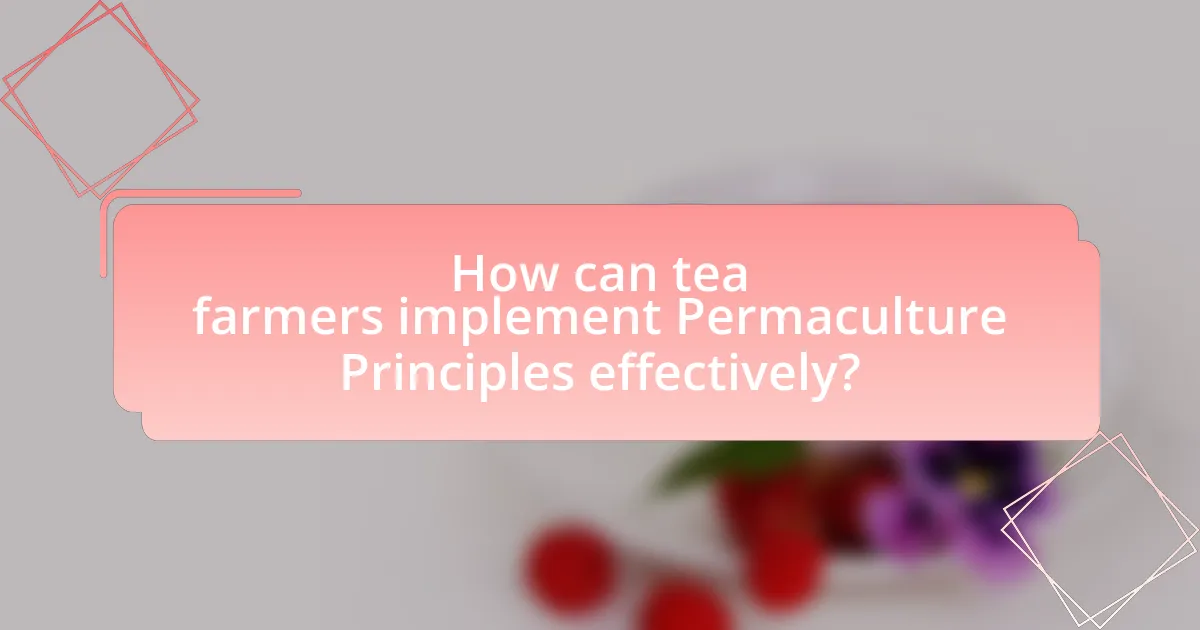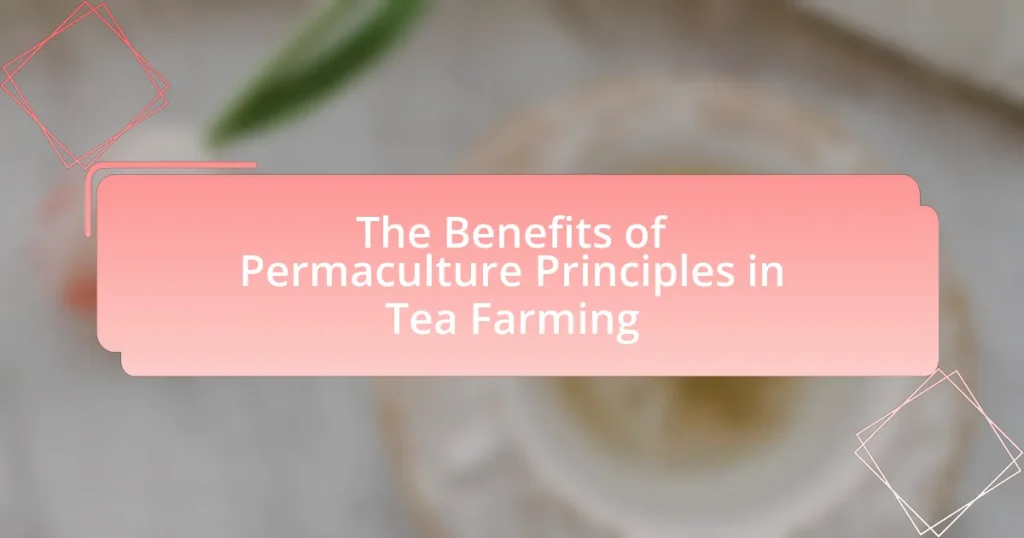The article focuses on the benefits of applying Permaculture Principles in tea farming, emphasizing sustainable practices that enhance biodiversity, improve soil health, and promote ecological balance. Key principles include observing and interacting with nature, capturing and storing energy, and valuing diversity, which collectively lead to increased resilience and productivity in tea cultivation. The article discusses specific practices such as companion planting, water conservation techniques, and soil regeneration methods that contribute to higher yields and better quality tea. Additionally, it addresses the challenges tea farmers may face when adopting these principles and outlines support systems and best practices for successful implementation.

What are the Permaculture Principles in Tea Farming?
The Permaculture Principles in tea farming include observing and interacting, capturing and storing energy, obtaining a yield, applying self-regulation and accepting feedback, using and valuing renewable resources, producing no waste, designing from patterns to details, integrating rather than segregating, using small and slow solutions, valuing diversity, and using edges and valuing the marginal. These principles guide sustainable practices that enhance biodiversity, improve soil health, and promote ecological balance in tea cultivation. For instance, integrating diverse plant species can reduce pest outbreaks and improve resilience, while capturing rainwater can enhance water availability for tea plants.
How do Permaculture Principles apply to agricultural practices?
Permaculture principles apply to agricultural practices by promoting sustainable land use, biodiversity, and ecological balance. These principles encourage practices such as companion planting, which enhances soil health and pest control, and the use of perennial crops, which reduce soil erosion and improve water retention. For instance, integrating nitrogen-fixing plants in tea farming can enhance soil fertility, leading to healthier tea plants and higher yields. Research indicates that permaculture practices can increase crop resilience and reduce the need for chemical fertilizers, thereby supporting both environmental sustainability and economic viability in agriculture.
What are the key components of Permaculture Principles?
The key components of Permaculture Principles include observing and interacting with nature, capturing and storing energy, obtaining a yield, applying self-regulation and accepting feedback, using and valuing renewable resources, producing no waste, designing from patterns to details, integrating rather than segregating, and using small and slow solutions. These principles guide sustainable agricultural practices by promoting ecological balance and resource efficiency. For instance, the principle of observing and interacting emphasizes understanding local ecosystems, which is crucial for optimizing tea farming practices that align with natural processes.
How do these components influence tea farming specifically?
Permaculture principles significantly influence tea farming by promoting sustainable agricultural practices that enhance soil health, biodiversity, and water management. These principles encourage the use of organic matter and natural fertilizers, which improve soil fertility and structure, leading to healthier tea plants and higher yields. For instance, integrating cover crops and mulching reduces soil erosion and retains moisture, essential for tea cultivation in varying climates. Additionally, permaculture emphasizes polyculture, which fosters a diverse ecosystem that can naturally control pests and diseases, reducing the need for chemical pesticides. Research indicates that farms employing permaculture practices can see a 20-30% increase in productivity compared to conventional methods, demonstrating the effectiveness of these components in enhancing tea farming outcomes.
Why is Permaculture important for sustainable tea farming?
Permaculture is important for sustainable tea farming because it promotes biodiversity, soil health, and resource efficiency. By integrating various agricultural practices, permaculture enhances the resilience of tea farms against pests and diseases, reducing the need for chemical inputs. Research indicates that permaculture systems can increase soil organic matter by up to 30%, which improves water retention and nutrient availability, essential for tea plants. Additionally, permaculture encourages the use of companion planting, which can lead to higher yields and better quality tea leaves, ultimately supporting sustainable farming practices.
What environmental benefits does Permaculture offer to tea farms?
Permaculture offers several environmental benefits to tea farms, including enhanced biodiversity, improved soil health, and efficient water management. By integrating diverse plant species and creating a balanced ecosystem, permaculture practices promote a habitat for beneficial insects and wildlife, which can naturally control pests and reduce the need for chemical pesticides. Additionally, permaculture techniques such as mulching and cover cropping improve soil structure and fertility, leading to healthier tea plants and increased yields. Efficient water management practices, such as swales and rainwater harvesting, help conserve water resources and reduce erosion, ensuring sustainable farming practices. These benefits collectively contribute to a more resilient and sustainable tea farming system.
How does Permaculture enhance biodiversity in tea cultivation?
Permaculture enhances biodiversity in tea cultivation by creating a diverse ecosystem that supports various plant and animal species. This approach integrates multiple layers of vegetation, such as trees, shrubs, and ground cover, which provide habitats and food sources for beneficial insects, birds, and other wildlife. Research indicates that polycultures, a key principle of permaculture, can increase species richness and resilience in agricultural systems. For instance, studies have shown that farms employing permaculture practices can host up to 50% more species compared to conventional monoculture tea plantations, leading to improved pest control and pollination services.

What specific benefits do Permaculture Principles provide in tea farming?
Permaculture principles provide several specific benefits in tea farming, including enhanced biodiversity, improved soil health, and increased resilience to climate change. By implementing permaculture practices, tea farmers can create diverse ecosystems that support beneficial insects and natural pest control, reducing the need for chemical pesticides. Additionally, permaculture emphasizes soil regeneration techniques, such as cover cropping and composting, which improve soil fertility and structure, leading to healthier tea plants. Furthermore, these principles promote water conservation and efficient use of resources, making tea farming more sustainable and adaptable to varying environmental conditions. Studies have shown that farms utilizing permaculture methods can yield higher quality tea while minimizing environmental impact, demonstrating the effectiveness of these principles in enhancing both productivity and sustainability in tea farming.
How can Permaculture improve soil health in tea plantations?
Permaculture can improve soil health in tea plantations by enhancing biodiversity, promoting organic matter retention, and fostering natural nutrient cycling. By implementing permaculture practices such as cover cropping, mulching, and agroforestry, tea plantations can increase soil organic carbon levels, which are crucial for soil fertility and structure. Research indicates that these practices can lead to a 30% increase in soil organic matter over time, significantly improving soil health and resilience against erosion and nutrient depletion. Additionally, the integration of diverse plant species can support beneficial microorganisms, further enhancing soil quality and promoting sustainable tea production.
What practices contribute to soil regeneration in tea farming?
Practices that contribute to soil regeneration in tea farming include cover cropping, composting, and agroforestry. Cover cropping involves planting specific crops that enhance soil structure and fertility, reducing erosion and improving moisture retention. Composting adds organic matter to the soil, enriching it with nutrients and promoting microbial activity essential for healthy soil ecosystems. Agroforestry integrates trees with tea plants, which helps in nutrient cycling, enhances biodiversity, and improves soil stability. These practices are supported by research indicating that organic matter and biodiversity significantly enhance soil health and productivity in agricultural systems, including tea farming.
How does improved soil health affect tea yield and quality?
Improved soil health significantly enhances tea yield and quality. Healthy soil promotes better nutrient availability, which directly influences the growth and development of tea plants. Research indicates that soils rich in organic matter and beneficial microorganisms can increase tea yields by up to 30% while also improving the flavor profile and antioxidant content of the leaves. For instance, a study published in the Journal of Agricultural Science found that tea grown in well-structured, nutrient-dense soils exhibited higher levels of polyphenols, which are crucial for both taste and health benefits. Thus, the relationship between soil health and tea production is critical for optimizing both quantity and quality.
In what ways does Permaculture promote water conservation in tea farming?
Permaculture promotes water conservation in tea farming through techniques such as rainwater harvesting, contour planting, and the establishment of swales. Rainwater harvesting captures and stores precipitation for irrigation, reducing reliance on external water sources. Contour planting involves planting tea bushes along the natural contours of the land, which minimizes soil erosion and maximizes water retention. Swales, which are shallow ditches designed to slow down water runoff, enhance groundwater recharge and maintain moisture levels in the soil. These methods collectively contribute to sustainable water management, ensuring that tea farms can thrive even in variable climatic conditions.
What techniques are used to manage water resources effectively?
Techniques used to manage water resources effectively include rainwater harvesting, drip irrigation, and watershed management. Rainwater harvesting captures and stores rainwater for agricultural use, reducing dependency on groundwater and improving water availability. Drip irrigation delivers water directly to plant roots, minimizing evaporation and runoff, which enhances water efficiency by up to 60% compared to traditional irrigation methods. Watershed management involves protecting and restoring natural water systems, ensuring sustainable water supply and quality. These techniques are supported by studies showing that integrated water resource management can lead to increased agricultural productivity and resilience against climate variability.
How does water conservation impact tea production sustainability?
Water conservation significantly enhances the sustainability of tea production by ensuring the efficient use of water resources, which is critical for maintaining healthy tea plants. Sustainable tea farming practices, such as rainwater harvesting and drip irrigation, reduce water waste and promote soil health, leading to higher yields and better quality tea. Research indicates that implementing water-saving techniques can decrease water usage by up to 50%, thereby minimizing the environmental impact and supporting the long-term viability of tea plantations. This approach not only conserves water but also helps mitigate the effects of climate change, ensuring that tea production remains resilient in the face of fluctuating weather patterns.

How can tea farmers implement Permaculture Principles effectively?
Tea farmers can implement Permaculture Principles effectively by designing their farms to mimic natural ecosystems, which enhances biodiversity and sustainability. This can be achieved through techniques such as intercropping tea with nitrogen-fixing plants, which improves soil fertility and reduces the need for chemical fertilizers. Additionally, farmers can create swales to manage water runoff and promote soil moisture retention, thereby reducing irrigation needs. Research indicates that farms utilizing permaculture practices can increase yields by up to 30% while decreasing input costs, demonstrating the effectiveness of these principles in enhancing both productivity and environmental health.
What are the first steps for integrating Permaculture into tea farming?
The first steps for integrating Permaculture into tea farming include conducting a site assessment to understand the existing ecosystem and designing a layout that incorporates diverse plant species. This approach enhances biodiversity, improves soil health, and optimizes water usage. Research indicates that integrating companion planting, such as growing nitrogen-fixing plants alongside tea, can significantly enhance soil fertility and pest resistance, leading to healthier tea crops.
How can farmers assess their current practices for Permaculture compatibility?
Farmers can assess their current practices for Permaculture compatibility by conducting a thorough evaluation of their agricultural methods against Permaculture principles, such as diversity, sustainability, and ecosystem health. This assessment involves analyzing soil health, water management, crop diversity, and the integration of animals and plants to create a self-sustaining system. Research indicates that farms implementing Permaculture principles can improve soil fertility and biodiversity, leading to increased resilience against pests and diseases. For example, a study published in the journal “Agriculture, Ecosystems & Environment” found that farms practicing Permaculture had significantly higher levels of soil organic matter and microbial activity compared to conventional farms. This evidence supports the effectiveness of Permaculture practices in enhancing agricultural sustainability.
What resources are available for farmers to learn about Permaculture?
Farmers can access various resources to learn about Permaculture, including online courses, books, workshops, and community organizations. Online platforms like the Permaculture Institute offer structured courses that cover the principles and practices of Permaculture. Books such as “Permaculture: A Designer’s Manual” by Bill Mollison provide in-depth knowledge and practical applications. Local workshops and hands-on training sessions organized by Permaculture design courses enable farmers to gain practical experience. Additionally, organizations like the Permaculture Research Institute and local farming cooperatives often host events and provide resources tailored to farmers interested in sustainable practices.
What challenges might tea farmers face when adopting Permaculture Principles?
Tea farmers may face several challenges when adopting Permaculture Principles, including initial investment costs, knowledge gaps, and resistance to change. The transition to permaculture often requires significant financial resources for redesigning farming systems and implementing sustainable practices, which can be a barrier for small-scale farmers. Additionally, many tea farmers may lack the necessary knowledge and training in permaculture techniques, making it difficult to effectively implement these principles. Furthermore, there may be cultural and institutional resistance to changing traditional farming methods, as farmers may be hesitant to abandon established practices that have been successful in the past. These challenges can hinder the successful adoption of permaculture in tea farming.
How can farmers overcome common obstacles in transitioning to Permaculture?
Farmers can overcome common obstacles in transitioning to Permaculture by implementing gradual changes, seeking education, and building community support. Gradual changes allow farmers to adapt their practices without overwhelming disruption, facilitating a smoother transition. Education through workshops and resources on Permaculture principles equips farmers with the necessary knowledge to implement sustainable practices effectively. Additionally, building community support fosters collaboration and resource sharing, which can alleviate challenges such as access to materials and knowledge gaps. Research indicates that farmers who engage in community networks report higher success rates in adopting sustainable practices, as seen in studies conducted by the Permaculture Research Institute.
What support systems exist for tea farmers implementing these principles?
Support systems for tea farmers implementing permaculture principles include agricultural extension services, cooperative organizations, and access to financial assistance programs. Agricultural extension services provide education and resources on sustainable farming practices, helping farmers adopt permaculture techniques effectively. Cooperative organizations facilitate knowledge sharing and collective marketing, enhancing farmers’ bargaining power and access to markets. Financial assistance programs, such as grants and low-interest loans, support the transition to permaculture by alleviating the economic burden associated with implementing new practices. These systems collectively empower tea farmers to adopt sustainable methods, improving both their livelihoods and environmental outcomes.
What best practices should tea farmers follow when applying Permaculture Principles?
Tea farmers should implement diverse cropping systems, integrate natural pest management, and enhance soil health when applying Permaculture Principles. Diverse cropping systems, such as intercropping tea with nitrogen-fixing plants, improve biodiversity and resilience against pests. Natural pest management techniques, including the use of beneficial insects and organic repellents, reduce reliance on chemical pesticides, promoting a healthier ecosystem. Enhancing soil health through practices like mulching, composting, and cover cropping increases soil fertility and water retention, which are crucial for sustainable tea production. These practices are supported by research indicating that permaculture methods can lead to increased yields and improved environmental outcomes in agricultural systems.


